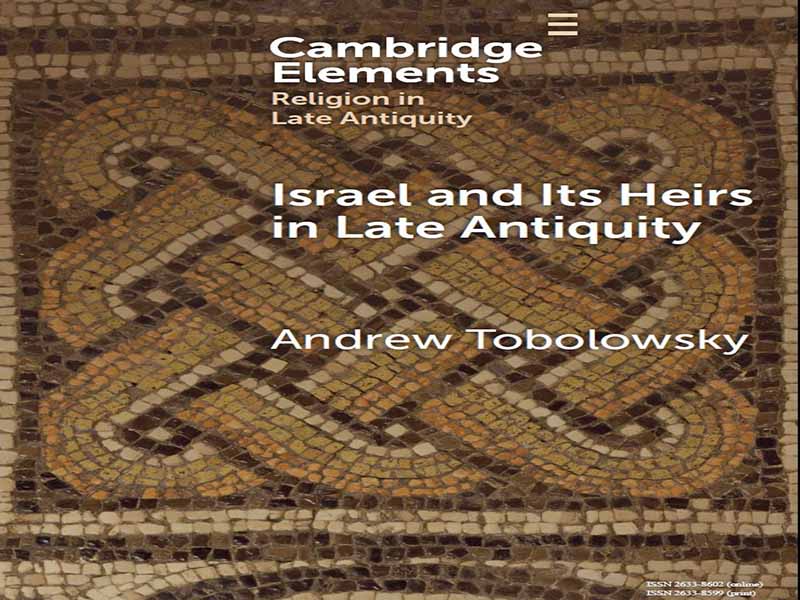- عنوان کتاب: ISRAEL AND ITS HEIRS IN LATE ANTIQUITY Israel
- نویسنده/انتشارات: Andrew S. Jacobs
- حوزه: اسرائیل
- سال انتشار: 2025
- تعداد صفحه: 74
- زبان اصلی: انگلیسی
- نوع فایل: pdf
- حجم فایل: 4.89 مگابایت
این مطالعه کوچکی که در دستان خود دارید، یا، همانطور که ممکن است، روی صفحه نمایش خود مشاهده کنید، دومین تلاش من برای ترسیم یک «جهان پر از اسرائیل» است. اولی، کتابی به نام افسانه دوازده قبیله اسرائیل، یک گردباد گردباد ارائه داد، یک بررسی از یک پدیده جذاب و هنوز بسیار نادیده گرفته شده: حضور هزاران سال اکنون گروه های مختلف بسیاری، در سراسر جهان، که به عنوان مردم اسرائیل معرفی می شوند. در این سفر بازگشت، قصد دارم سرعتی آرامتر داشته باشم و بر رقابت بر سر هویت و میراث اسرائیل بین یهودیان، اسرائیلیهای سامری، و مسیحیان تمرکز کنم، بهویژه در عصری که محققان به آن دوران باستان میگویند، که عموماً به عنوان دورهای تعریف میشود که در حدود قرن سوم پس از میلاد آغاز شد و تا قرن هفتم یا هشتم ادامه یافت. در واقع، در این بازه، من تا حد زیادی بر نیمه اول تمرکز خواهم کرد، و در آن سطح پروژه این قطعه، اگر ساده نباشد، حداقل ساده است. با این حال، کتاب اول نه تنها در مورد اسرائیل، بلکه در مورد خود پدیده هویت قومی بود. نکته مهمی که میخواستم به آن اشاره کنم این است که صرف وجود گروههای مختلف که بهعنوان گروه «یکسان» شناخته میشوند، کاملاً مستقل از یکدیگر، بیشتر از آن چیزی که بسیاری تصور میکنند، بهعنوان گروههای منحصربهفرد با ویژگیهای خاص و کاملاً تعریفشده، چالشی برای شیوههای معمول تفکر درباره هویت قومی است. به همین ترتیب، و بیشتر در مورد این مطالعه، من فکر میکنم که ما تمایل داریم گروههای قومی را تصور کنیم که هویتهای خود را حول مجموعهای از سنتهای گرامی میسازند که به طور خاص و ذاتاً متعلق به آنها است، که از نسلها به نسلها منتقل شده است، و اگر آنها خودشان را دوبارهسازی کنند، عمدتاً با بیان این داستانها به روشهای جدید است. اما در اینجا میبینیم که گروههای مختلفی که همانطور که گفتم، هویت یکسانی را اتخاذ میکنند، از سنتهای مشابه یکدیگر استفاده میکنند، و سنتهایی را که نه در اصل و نه بههیچوجه متعلق به آنها بوده است. در عوض، این سنتها سنتهایی هستند که زمانی به تنهایی دارایی خاص اسرائیلیها و یهودیان باستان بود، و اکنون در کتابی که تا حدودی دارایی مشترک بسیاری از گروهها است، ظاهر میشوند: کتاب مقدس عبری. و اگر اعضای یک گروه، یا گروههای مختلف، بتوانند به رختخواب بروند و خود را یک چیز بدانند، و از خواب بیدار شوند و خود را اسرائیلی بدانند، و از سنتهایی استفاده کنند که «از آنها» نیست، شاید تا آنجا که به پدیدههای قومی مربوط میشود، خیلی بیشتر از آنچه ما اغلب تصور میکنیم امکانپذیر باشد. در واقع، معلوم میشود که «اسرائیل شدن» به هیچ وجه پدیدهای بینمونه نیست. در دنیای باستان، و حتی در دوره قرون وسطی، تعدادی از افراد و گروههای مختلف وجود داشتند که همگی ادعا میکردند که از قهرمانان جنگ تروا تبار هستند. داستان هایی که این ادعا را مطرح می کنند عبارتند از Aeneid، داستانی رومی درباره بنیانگذاران تروا. و من درک می کنم که حتی در دوره های اخیر، ایدئولوژی نازی بر ارتباط قوی بین آلمان نازی و اجداد کلاسیک مختلف، به ویژه یونان باستان تأکید داشت. با این حال، از نظر وسعت، عمق و مدت تاریخی، «اسرائیل شدن» در واقع منحصر به فرد است و در نتیجه فرصتی منحصر به فرد برای یادگیری چیزهای جدیدی در مورد هویت قومی ارائه می دهد. مطمئناً، در مطالعه این که چگونه بسیاری از گروههای مختلف هویت «یکسان» را از سنتهای «یکسان» در زمانها و مکانهای مختلف میسازند، میتوانیم در مورد اینکه یک هویت واقعاً چقدر شکلهای مختلف میتواند داشته باشد و سنتهای یکسان واقعاً برای انجام چند چیز مختلف میتوان استفاده کرد، چیزهای زیادی یاد گرفت.
This little study you hold in your hands, or, as it may be, view on your screen marks my second attempt to map a “world full of Israels.” The first, a book called The Myth of the Twelve Tribes of Israel offered a whirlwind tour, a survey of a fascinating and still much neglected phenomenon: the presence for thousands of years now of many different groups, all around the world, who identify as the people Israel. On this return trip, I intend a more leisurely pace focusing narrowly on the competition over the identity and legacy of Israel between Jews, Samaritan Israelites, and Christians, specifically in the era known to scholars as Late Antiquity, generally defined as a period that began around the turn of the third century CE and continued into the seventh or eighth. Indeed, within that span, I will largely focus on the first half, and on that level the project of this piece is, if not simple, then at least straightforward. Yet the first book was not only about Israels but about the phenomenon of ethnic identity itself. One important point I wanted to make is that the mere existence of so many different groups identifying as the “same” group, quite independently of each other, is more of a challenge to typical ways of thinking about ethnic identity than many realize, which is to say, as unique groups with particular and well-defined characteristics. Similarly, and more to the point of this study, I think we tend to imagine ethnic groups building their identities around a single, cherished repertoire of traditions that is specifically and intrinsically theirs, passed down through the generations, and that if they refashion themselves, it is largely by telling these stories in new ways. But here we see a wide variety of groups adopting, as I say, the same identity, using the same traditions as each other, and traditions that were also neither theirs originally nor uniquely theirs in any sense at all. Instead, they are traditions that were once the special property of the ancient Israelites and Judahites alone, now appearing in a book that is, to some extent, the common property of many groups: the Hebrew Bible. And if the members of a group, or different groups, can go to bed thinking of themselves as one thing, and wake up thinking of themselves as Israelites, and use traditions that are not “theirs,” maybe a lot more is possible, as far as ethnic phenomena are concerned, than we often suppose. Indeed, it turns out that “becoming Israel” is by no means an otherwise unexampled phenomenon. In the ancient world, and even into the medieval period, there were a number of different individuals and groups who all claimed descent from the heroes of the TrojanWar. Stories that make this claim include the Aeneid, a Roman story about Trojan founders. And I understand that, even in more recent periods, Nazi ideology stressed a strong connection between Nazi Germany and various classical forebears, especially ancient Greece. In breadth, depth, and historical duration, however, “becoming Israel” is indeed unique and as a result offers a unique opportunity to learn something new about ethnic identity itself. Certainly, in studying how so many different groups construct the “same” identity from the “same” traditions in different times and places, we can learn a lot about how many different shapes the same identity can really take and how many different things the same traditions can really be used to do.
این کتاب را میتوانید از لینک زیر بصورت رایگان دانلود کنید:
Download: ISRAEL AND ITS HEIRS IN LATE ANTIQUITY




































نظرات کاربران